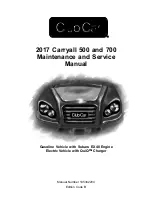
GENERAL INFORMATION
Pre-Operation Checklist
Page 3-2 2000 Turf/Carryall Vehicle Maintenance and Service Manual
3
• Warning Decals:
Check to ensure all warning and operation decals are in place.
See the Turf or Car-
ryall Owner’s Manual.
• Tires:
Check for proper tire pressure.
See Section 2 – Specifications
.
• Batteries (electric vehicles):
Check electrolyte to ensure it is at its proper level.
See Section 13 –
Batteries, in the appropriate maintenance and service supplement
. Check battery posts. Wires
should be tight and free of corrosion. Charge batteries completely before using vehicle for the first time.
• Multi-Step Potentiometer (Turf 1 and Carryall 1 electric vehicles):
Be sure potentiometer (wiper
switch) cover is properly secured prior to operating the vehicle.
• Engine (gasoline vehicle):
Check for proper engine oil level.
See Engine Oil, Section 10 – Mainte-
nance, in the appropriate maintenance and service supplement
.
• Fuel (gasoline vehicle):
Check fuel level.
See Fueling Instructions, Section 10 – Maintenance, in
the appropriate maintenance and service supplement
.
PERFORMANCE INSPECTION
After becoming familiar with the vehicle’s controls and after reading and understanding the driving instruc-
tions, take the vehicle for a test drive. Use the following checklist as a guide to inspect the new vehicle. Any
problems should be corrected by a Club Car dealer or a Club Car factory trained technician.
All Vehicles
• Brakes:
Be sure the brakes function properly. When brake pedal is fully depressed under moderate
pressure, it should
not
go more than halfway to the floor, and vehicle should come to a smooth, straight
stop. If the brake pedal goes more than halfway to the floor, or if the vehicle swerves or fails to stop,
have the brake system checked and adjusted as required. Brake adjustment must be maintained so the
brake pedal
cannot
be depressed to the floor under any circumstance.
• Park Brake:
When latched, the park brake should lock the wheels and hold vehicle stationary (on
incline of 20% or less). The park brake should release when either the accelerator or brake pedal is
depressed.
• Reverse Buzzer:
The reverse buzzer(s) should sound as a warning when the vehicle is in REVERSE.
• Steering:
The vehicle should be easy to steer and should not have any play in the steering wheel.
• Accelerator:
• Pedal-Start Vehicles:
With the key switch in the ON position and the Forward/Reverse handle in the
FORWARD position, depress accelerator pedal. As pedal is depressed, the engine or motor should
start and the vehicle should accelerate smoothly to full speed. When pedal is released it should return
to the original position and the engine or motor should stop. Club Car vehicles operate at reduced
speed when in REVERSE.
• Key-Start Vehicles:
After starting engine with the key switch, the vehicle should accelerate smoothly to
full speed as the accelerator pedal is depressed. When the pedal is released it should return to the
original position and engine should idle.
• Governor (gasoline vehicles):
Check maximum speed of the vehicle. Turf 1, Turf 2 and Carryall 1
vehicles should operate at 12-15 mph (19-24 km/h) on a level surface. The Turf 6, Carryall 6 and Carry-
all 2 vehicles should operate at 14-16 mph (23-26 km/h) on a level surface. The Carryall 2 Plus should
•
BE SURE THE PLASTIC HAS BEEN REMOVED FROM THE SEAT BOTTOM BEFORE
OPERATING THE VEHICLE. FAILURE TO DO SO MAY RESULT IN A FIRE, PROPERTY
DAMAGE, PERSONAL INJURY, OR DEATH.
WARNING
Содержание CARRYALL 1 2000
Страница 2: ......
Страница 10: ......
Страница 14: ...1...
Страница 18: ...2...
Страница 36: ...3...
Страница 50: ...4...
Страница 116: ...7...
Страница 130: ...9...
Страница 134: ......
Страница 135: ......
Страница 136: ...Golf Cars and Utility Vehicles Club Car Inc P O Box 204658 Augusta GA 30917 4658...































